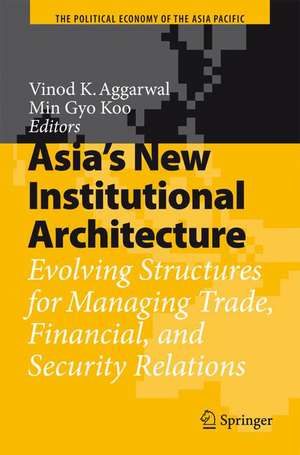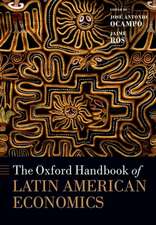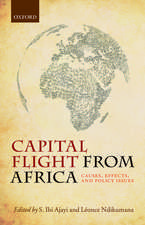Asia's New Institutional Architecture: Evolving Structures for Managing Trade, Financial, and Security Relations: The Political Economy of the Asia Pacific
Editat de Vinod K. Aggarwal, Min Gyo Kooen Limba Engleză Hardback – 17 oct 2007
| Toate formatele și edițiile | Preț | Express |
|---|---|---|
| Paperback (1) | 1220.45 lei 6-8 săpt. | |
| Springer Berlin, Heidelberg – 4 feb 2008 | 1220.45 lei 6-8 săpt. | |
| Hardback (1) | 1224.36 lei 6-8 săpt. | |
| Springer Berlin, Heidelberg – 17 oct 2007 | 1224.36 lei 6-8 săpt. |
Din seria The Political Economy of the Asia Pacific
- 15%
 Preț: 649.06 lei
Preț: 649.06 lei -
 Preț: 389.31 lei
Preț: 389.31 lei - 20%
 Preț: 550.14 lei
Preț: 550.14 lei - 15%
 Preț: 639.25 lei
Preț: 639.25 lei - 15%
 Preț: 639.25 lei
Preț: 639.25 lei - 18%
 Preț: 1222.94 lei
Preț: 1222.94 lei - 20%
 Preț: 566.75 lei
Preț: 566.75 lei -
 Preț: 385.84 lei
Preț: 385.84 lei - 23%
 Preț: 773.65 lei
Preț: 773.65 lei -
 Preț: 382.18 lei
Preț: 382.18 lei -
 Preț: 262.09 lei
Preț: 262.09 lei - 15%
 Preț: 652.17 lei
Preț: 652.17 lei - 15%
 Preț: 646.30 lei
Preț: 646.30 lei - 24%
 Preț: 631.50 lei
Preț: 631.50 lei - 18%
 Preț: 720.53 lei
Preț: 720.53 lei -
 Preț: 197.79 lei
Preț: 197.79 lei - 15%
 Preț: 637.13 lei
Preț: 637.13 lei -
 Preț: 369.48 lei
Preț: 369.48 lei
Preț: 1224.36 lei
Preț vechi: 1493.13 lei
-18% Nou
Puncte Express: 1837
Preț estimativ în valută:
234.31€ • 239.95$ • 194.91£
234.31€ • 239.95$ • 194.91£
Carte tipărită la comandă
Livrare economică 18 martie-01 aprilie
Preluare comenzi: 021 569.72.76
Specificații
ISBN-13: 9783540723882
ISBN-10: 3540723889
Pagini: 340
Ilustrații: XVI, 322 p. 2 illus.
Dimensiuni: 155 x 235 x 24 mm
Greutate: 0.64 kg
Ediția:2008
Editura: Springer Berlin, Heidelberg
Colecția Springer
Seria The Political Economy of the Asia Pacific
Locul publicării:Berlin, Heidelberg, Germany
ISBN-10: 3540723889
Pagini: 340
Ilustrații: XVI, 322 p. 2 illus.
Dimensiuni: 155 x 235 x 24 mm
Greutate: 0.64 kg
Ediția:2008
Editura: Springer Berlin, Heidelberg
Colecția Springer
Seria The Political Economy of the Asia Pacific
Locul publicării:Berlin, Heidelberg, Germany
Public țintă
ResearchCuprins
Asia’s New Institutional Architecture: Evolving Structures for Managing Trade, Financial, and Security Relations.- Asia’s New Economic Institutions.- Building Asian Security Institutions Under the Triple Shocks: Competitive, Complementary or Juxtaposed?.- Regional Arrangements for Trade in Northeast Asia: Cooperation and Competition between China and Japan.- Security Institutions in Northeast Asia: Multilateral Responses to Structural Changes.- Southeast Asia’s New Institutional Architecture for Cooperation in Trade and Finance.- Southeast Asia’s New Security Institutions.- India’s Shifting Trade Policy: South Asia and Beyond.- The Evolution of Post-Cold War Regional Security Institutions in South Asia.- The Past, Present, and Future of Asia’s Institutional Architecture.
Recenzii
From the reviews:
“It presents a historical overview of the economic and security arrangements relevant for … geopolitical and geoeconomic events. … The book is intended to be read … by political scientists/commentators, security experts, and economists. It probably does a good job of enthusing the political scientists and security experts … . In summary, this is an important book … . will definitely appeal to political commentators and those looking for historical details on the evolution of institutions in Asia.” (Devesh Roy, American Journal of Agricultural Economics, Vol. 93 (1), January, 2011)
“It presents a historical overview of the economic and security arrangements relevant for … geopolitical and geoeconomic events. … The book is intended to be read … by political scientists/commentators, security experts, and economists. It probably does a good job of enthusing the political scientists and security experts … . In summary, this is an important book … . will definitely appeal to political commentators and those looking for historical details on the evolution of institutions in Asia.” (Devesh Roy, American Journal of Agricultural Economics, Vol. 93 (1), January, 2011)
Textul de pe ultima copertă
This book investigates the origins and evolution of Asia’s new institutional architecture in trade, finance, and security from both a theoretical and empirical perspective. The traditional institutional equilibrium in Asia has come under heavy strain in the "post triple shocks period" - the post-Cold War, the post-financial crisis of 1997-98, and the post-9-11 attacks. The new dynamics of rivalry and cooperation among states at both the intraregional and transregional levels is now shaping a new institutional architecture. Political and business leaders from Northeast and Southeast Asia interact with each other more frequently. South Asia’s participation in the rest of Asia in recent years is truly impressive. As we show, the future institutional trajectory of Asia is still open, but we believe that the book provides a timely examination of key shifts in the region. In doing so, our hope is to provide policymakers and analysts with an institutional road map for the future.
The first comparative systematic study of Asia’s emerging economic and security architecture. Via a series of theoretically sophisticated, yet empirically rich studies of Asia´s contemporary regional economic and security structures, Aggarwal, Koo and their colleagues, using an institutional bargaining approach, provide a template for the analysis of a most important set of evolving international relationships. This volume, while measured in its conclusions and sensitive to the problematic nature of Asian cooperation, nevertheless leaves us in little doubt as to both the theoretical and policy significance of the regional institutional endeavours in train in the early 21st century.
Richard Higgott, University of Warwick
This volume offers a fresh and analytically rigorous perspective on the changing role of Asia's regional institutions since the end of the Cold War. Offering valuable insights into their design and function, this book challenges theconventional wisdom that regional institutions play a marginal role in Asia's economic and security architecture. The publication of this volume is a testimony to the increasing theoretical sophistication and empirical richness of the study of Asian regionalism as a field of scholarly inquiry in its own right.
Amitav Acharya, University of Bristol
The first comparative systematic study of Asia’s emerging economic and security architecture. Via a series of theoretically sophisticated, yet empirically rich studies of Asia´s contemporary regional economic and security structures, Aggarwal, Koo and their colleagues, using an institutional bargaining approach, provide a template for the analysis of a most important set of evolving international relationships. This volume, while measured in its conclusions and sensitive to the problematic nature of Asian cooperation, nevertheless leaves us in little doubt as to both the theoretical and policy significance of the regional institutional endeavours in train in the early 21st century.
Richard Higgott, University of Warwick
This volume offers a fresh and analytically rigorous perspective on the changing role of Asia's regional institutions since the end of the Cold War. Offering valuable insights into their design and function, this book challenges theconventional wisdom that regional institutions play a marginal role in Asia's economic and security architecture. The publication of this volume is a testimony to the increasing theoretical sophistication and empirical richness of the study of Asian regionalism as a field of scholarly inquiry in its own right.
Amitav Acharya, University of Bristol
Caracteristici
Offers a fresh and analytically rigorous perspective on the changing role of Asia's regional institutions Demonstrates the increasing theoretical sophistication and empirical richness of the study of Asian regionalism Includes supplementary material: sn.pub/extras





